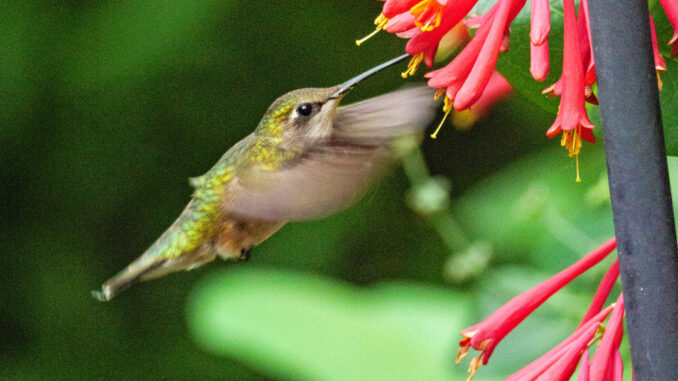
Preparing for days in a warmer climate, take some time to review how the garden tolerated the heat wave of the past summer. New strategies for sustaining plants through excessive heat and rain will be necessary going forward. But be assured that you can sweeten the deal next summer by planting an old-fashioned, always beautiful flowering vine.
Modern honeysuckles, flowering vines for any garden
Honeysuckle vines (Lonicera spp.) are also known as woodbine, celebrated in literature and as hand-painted décor on the thinnest of bone china teacups. There are 180 known species of honeysuckle, and nine of them are indigenous to Canada. Many of the species are listed as wildflowers, and their flaring trumpet blossoms are often scented and carry drops of sweet nectar in their throats. All of them will grow and flower in part-shade to full-sun locations.
The wild honeysuckles have one blooming period in spring and can be quite rampant, with vines requiring control in gardens. Hybridized honeysuckles have been bred with shortened vine lengths and ever-blooming displays, from late spring through autumn. They are fancy flowers, making a splash of flared trumpet petals with vivid colouring requiring only simple support.
Two that give a vivid display are ‘Major Wheeler’ – growing eight to 10 feet, with dense clusters of deep scarlet flowers (but no scent) and ‘Gold Flame’ – growing 10 to 15 feet, with scented pink flower tubes flaring open to show a peachy yellow interior.
The vines require little space for climbing as their path is not straight up, but in pliable horizontal branching that is easily wrapped around and anchored to any frame or fence. Honeysuckle vines are short enough to wind around a small trellis or drape across a pergola and can even been supported by a sturdy tomato cage and bamboo canes. Hummingbirds love these blooms and will visit them frequently throughout the day.
The key to getting repeat bloom through the summer is to cut back flowering stems when the first flower flush is finished. Shorten flowering branches by about a quarter of their length, and that will trigger enough growth from remaining bud in leaf axils to form new flowers. As with all flowering plants, be sure to provide regular water.
Coping with heat waves
No one would think of Canada as a hot climate. But weather patterns can change and record-setting heat settled in for scorching weeks this past summer over many parts of the country. Plants grow most comfortably between 15C and 30C (59F and 86F), with approximately two inches of water weekly from combined rain and irrigation. During the past summer months, many areas of Canada significantly exceeded those historical guidelines and will probably do so again. In many locations across the country, flower beds and vegetable patches shriveled during weeks of unrelenting high temperatures. In a stark reversal, flooding torrential rains exceeded ground capacity to absorb water, transforming lawns into lakes.
Gardeners need defensive strategies when plants are experiencing environmental stress. Mulching exposed soil at the base of hedges and in plant beds with organic materials such as leaves and grass clippings is an effective way to shield plant roots from heat. Sunlight is most intense between noon and 4 p.m., when the sun is highest in the sky. Ornamental plants respond to heat stress by ceasing flower production and turning to seed-making. Removing seed heads of spent flowers will help to save plant energy for new flower buds produced when the heat is past.
Food plants such as tomatoes and summer squashes may drop their flowers when heat is above 32C (90F) and will renew flowers when temperatures recede into more normal range. Large-leaved plants such as pumpkins can develop crispy, brown leaf edges showing signs of sun scald, although the interior leaf may remain green. Flowering ornamentals and vegetables will cup and roll their leaves inward, shielding tissues from scorching ultraviolet light. When high heat combines with poor air quality from wildfires, foliage damage can be the result in cucumbers, squash and tomatoes. Watching for these distress signs in plants will be the cue to provide some form of protection where possible.
If plants are in containers, move them into shaded areas out of direct sunlight. They can live there for several days, or even weeks, until the heat dissipates. For plants grown in beds, quick rigging of temporary shade provided by a beach umbrella (or a photographer’s umbrella clamped onto a chair arm) will shield tender leaves from the burning glare. Wilting stems are a sign that plant roots are unable to pump water fast enough to reach leaves. Provide shade any way you can and water twice a day – in the morning to get the plants through the aggressive daylight heat, and at night to renew water in depleted stems and leaf tissues. Wilting is an extreme form of environmental distress and the longer a plant remains wilted, the more likely it is to not recover.
As summer rolls on, rain arrives in intense and unprecedented amounts. It’s wise to mound up rows when planting spring vegetable beds, allowing plants to stand taller above the basic grade and encouraging excessive water to roll away. (Mounded rows should be mulched to encourage sufficient moisture to remain in the root zone.) Lawns can be quickly turned into lakes by flooding torrential rain. Many lawn areas are grown on compacted soil, slowing the drainage and leaving wet pools for hours or days. The best way to prevent these lasting flood pools is to have the lawn core aerated every autumn. After successive years of the aeration process, the soil under the lawn will be less compacted and able to drain water more quickly.
With the experiences of recent intense weather systems, we need to be more aware of growing conditions and read the signs of environmental distress. It seems as if the new weather patterns may be with us for an extended period, but forewarned is forearmed. We’ll be prepared to help the garden along whatever may come next year.

